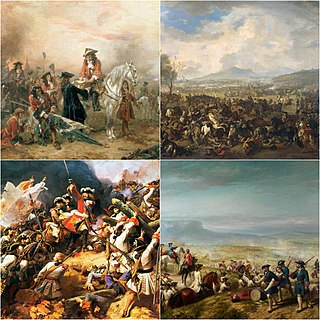
The War of the Spanish Succession was a European great power conflict fought between 1701 and 1714. The immediate cause was the death of the childless Charles II of Spain in November 1700, which led to a struggle for control of the Spanish Empire. His nominated heir was Philip of Anjou, a grandson of Louis XIV of France, whose main backers were France and most of Spain. His rival, Archduke Charles of Austria, was supported by the Grand Alliance, whose primary members included the Holy Roman Empire, the Dutch Republic, and Great Britain. Significant related conflicts include the 1700 to 1721 Great Northern War, and Queen Anne's War in North America.

Thomas Francis of Savoy, 1st Prince of Carignano was an Italian military commander and the founder of the Carignano branch of the House of Savoy, which reigned as kings of Piedmont-Sardinia from 1831 to 1861, and as kings of Italy from 1861 until the dynasty's deposition in 1946.
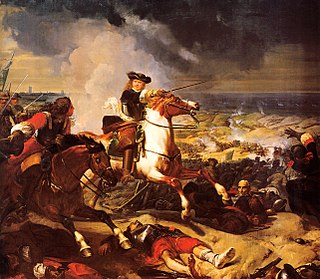
The Battle of the Dunes, also known as the Battle of Dunkirk, took place on 14 June 1658, near the strategic port of Dunkirk in what was then the Spanish Netherlands. Part of the Franco-Spanish War and concurrent Anglo-Spanish War, a French army under Turenne, supported by troops from the Commonwealth of England, had besieged Dunkirk. Led by John of Austria the Younger and Louis, Grand Condé, a Spanish force supported by English Royalists and French Fronde rebels attempted to raise the siege but suffered a severe defeat.

The Battle of Turckheim took place during the Franco-Dutch War that occurred on 5 January 1675 at a site between the towns of Colmar and Turckheim in Alsace. The French army, commanded by the Viscount of Turenne, defeated the armies of Austria and Brandenburg, led by Alexander von Bournonville and Frederick William, Elector of Brandenburg.
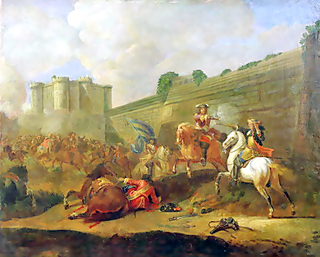
The Fronde was a series of civil wars in the Kingdom of France between 1648 and 1653, occurring in the midst of the Franco-Spanish War, which had begun in 1635. The government of the young King Louis XIV confronted the combined opposition of the princes, the nobility, the law courts (parlements), as well as much of the French population, and managed to subdue them all. The dispute started when the government of France issued seven fiscal edicts, six of which were to increase taxation. The parlements resisted, questioned the constitutionality of the king's actions, and sought to check his powers.

Henri de La Tour d'Auvergne, vicomte de Turenne, commonly known as Turenne, was a French general and one of only six Marshals to have been promoted Marshal General of France. The most illustrious member of the La Tour d'Auvergne family, his military exploits over his five-decade career earned him a reputation as one of the greatest military commanders in history.
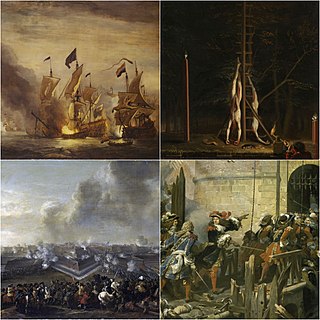
The Franco-Dutch War, also known as the Dutch War, was fought between France and the Dutch Republic, supported by its allies the Holy Roman Empire, Spain, Brandenburg-Prussia and Denmark-Norway. In its early stages, France was allied with Münster and Cologne, as well as England. The 1672 to 1674 Third Anglo-Dutch War and 1675 to 1679 Scanian War are considered related conflicts.
The Battle of Bléneau was a battle of the Second Fronde fought on April 7, 1652, near Bléneau in France between the armies of the rebel Louis II de Bourbon, Prince de Condé and the Royalist Henri de la Tour d'Auvergne, Vicomte de Turenne. Condé destroyed part of the Royalist army but failed to exploit his victory, retreating to Paris. Turenne regrouped and laid siege to the rebels at Étampes.

Franz Freiherr von Mercy, Lord of Mandre and Collenburg, was a German field marshal in the Thirty Years' War who fought for the Imperial side and was commander-in-chief of the Bavarian army from 1643 to 1645. In that role, he destroyed a French army at Tuttlingen (1643), stalemated another at Freiburg (1644), destroyed a third French army at Herbsthausen (1645) and was killed at the Second Battle of Nördlingen (1645).
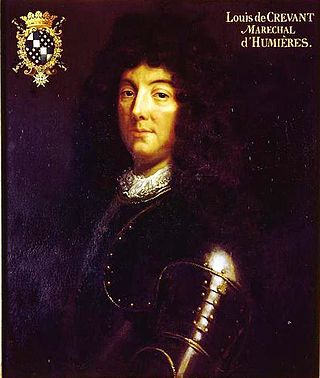
Louis de Crévant, Marquis then later duc d'Humières (1628–1694) was a French nobleman of the 17th century, who became a Marshal of France in 1668 and Grand Master of Artillery in 1685.

The siege of Lille took place during the War of Devolution. Louis XIV's forces besieged Lille from 10 August to 28 August 1667. It was the only major engagement of the war. Lille was the first major victory for Vauban’s siege techniques. Louis XIV, arguing that the Spanish dowry of his wife Maria Theresa of Spain had not been paid, began to expand French borders to the north and east, invading the Spanish Netherlands. This began a conflict with Spain that became the War of Devolution. After taking Charleroi, Tournai and Douai, French troops laid siege to Lille, at that time part of the county of Flanders under Spanish rule. Siege techniques applied by the French military engineer Vauban were instrumental in their capture.

The siege of Cádiz was a siege of the large Spanish naval base of Cádiz by a French army from 5 February 1810 to 24 August 1812 during the Peninsular War. Following the occupation of Seville, Cádiz became the Spanish seat of power, and was targeted by 70,000 French troops under the command of the Marshals Claude Victor and Nicolas Jean-de-Dieu Soult for one of the most important sieges of the war. Defending the city were 2,000 Spanish troops who, as the siege progressed, received aid from 10,000 Spanish reinforcements as well as British and Portuguese troops.

The 1640 siege of Turin was a major action in two distinct wars: the Franco-Spanish War (1635–59) and the Piedmontese Civil War. When Thomas Francis, Prince of Carignano and his Piedmontese faction captured Turin, the French garrison supporting the Regent Christine Marie of France retired within the citadel and continued to resist. A Franco-Piedmontese army led by Henri de Lorraine, count of Harcourt and Henri de la Tour d'Auvergne, Vicomte de Turenne invested the forces under Prince Thomas within the city. Finally, a Spanish army under Diego Felipez de Guzmán, Marquis of Leganés appeared and encircled the French besiegers. In this triple siege, the Spanish army surrounded the French army which surrounded Prince Thomas' Piedmontese who surrounded the French controlled citadel. In the end the French prevailed; Prince Thomas surrendered on terms and was allowed to march his troops elsewhere, leaving Turin in French control. Turin is a major city in the northwest part of modern-day Italy.
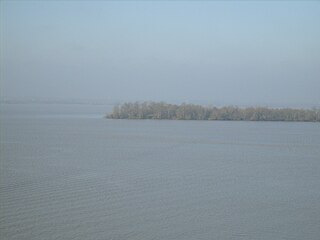
The Battle of Bordeaux was a naval engagement of the Franco-Spanish War of 1635–1659 fought on 20 October 1653 in the Gironde estuary. A Spanish fleet under Álvaro de Bazán, 3rd Marquis of Santa Cruz, sent to relieve Bordeaux, at that time held by the nobles rose up against Louis XIV during the Fronde, encountered a great concentration of French warships belonging to Duke of Vendome's army in the channel of Blaye and captured or destroyed most of it. Shortly after a landing was made by some 1,600 soldiers of the Spanish Tercios which sacked the village of Montagne-sur-Gironde. A similar attempt in the Island of Ré was repulsed, so Santa Cruz, having accomplished his orders, returned to Spain.
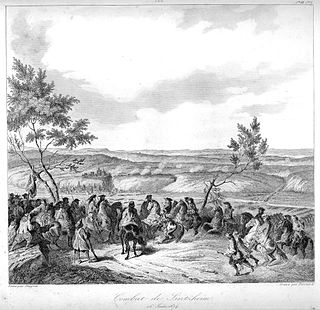
The Battle of Sinsheim took place on 16 June 1674, near Sinsheim in modern Baden-Württemberg, then in the Holy Roman Empire. Part of the 1672 to 1678 Franco-Dutch War, a French army under Marshall Turenne defeated an Imperial force led by Aeneas de Caprara.

The Battle of Entzheim, also called Enzheim, or Ensheim, took place on 4 October 1674, during the 1672 to 1678 Franco-Dutch War. It was fought near the town of Entzheim, south of Strasbourg in Alsace, between a French army under Turenne, and an Imperial force commanded by Alexander von Bournonville.

The siege of Calais of 1596, also known as the Spanish conquest of Calais, took place at the strategic port-city of Calais, between 8 and 24 April 1596, as part of the Franco-Spanish War (1595–1598), in the context of the French Wars of Religion, the Anglo-Spanish War (1585–1604), and the Eighty Years' War. The siege ended when the city fell into Spanish hands after a short and intense siege by the Spanish Army of Flanders commanded by Archduke Albert of Austria, Governor-General of the Spanish Netherlands. The French troops in the citadel of Calais resisted for a few days more but finally, on 24 April, the Spanish troops led by Don Luis de Velasco y Velasco, Count of Salazar, assaulted and captured the fortress, achieving a complete victory. The Spanish success was the first action of the campaign of Archduke Albert of 1596.

The siege of Dunkirk in 1658 was a military operation by the allied forces of France and Commonwealth England intended to take the fortified port city of Dunkirk, Spain's greatest privateer base, from the Spanish and their confederates: the English royalists and French Fronduers. Dunkirk was a strategic port on the southern coast of the English Channel in the Spanish Netherlands that had often been a point of contention previously and had changed hands a number of times. Privateers operating out of Dunkirk and other ports had cost England some 1,500 to 2,000 merchant ships in the past year. The French and their English Commonwealth allies were commanded by Marshal of France Turenne. The siege would last a month and featured numerous sorties by the garrison and a determined relief attempt by the Spanish army under the command of Don Juan of Austria and his confederate English royalists under Duke of York and rebels of the French Fronde under the Great Condé that resulted in the battle of the Dunes.

The siege of Philippsburg was a French siege of the Rhine fortress of Philippsburg during the Thirty Years' War. After the battle of Freiburg in early August, the French under the Duc d'Enghien refrained from attacking the city and marched north to besiege the imperial-held Philippsburg instead. The place fell after a two-week siege.

The siege of Grave took place from 25 July to 27 October in 1674 during the Franco-Dutch War of 1672 to 1678, when a Dutch army captured the Dutch fortress town of Grave in what is now North Brabant. Grave had been occupied by the French since the summer of 1672 when an army under Turenne forced the town to surrender.


















